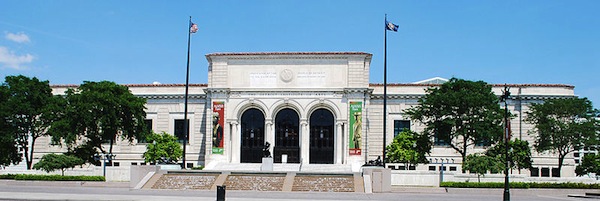
Final week to see “Detroit Revealed” at the Detroit Institute of Arts
“Detroit Revealed: Photographs 2000-2010,” a multimedia show at the Detroit Institute of Arts (a Knight Arts grantee) will conclude its six-month run next Sunday, April 29. The show features video and still photographs from eight contemporary artists, all taking a view on Detroit in the last decade, and has run in tandem with a series of Detroit-related documentaries playing at the Detroit Film Theater. The collective presentation of Detroit is as varied as the show’s participants: Corine Vermeulen, Carlos Diaz, Andrew Moore, Scott Hocking, Dawoud Bey, Michelle Andonian, Alec Soth and Ari Marcopoulos.
Some focus on the aspects of a dying era, such as Andonian’s look at the flailing auto industry, with production exquisitely rendered in works such as “End of the Frame Line.” One wonders if such glorification resonates with anyone who had worked at one of the auto plants (as I overheard one viewer comment, “That looks cleaner than any assembly line I ever saw!”) Similarly, Hocking is a well-know documenter of Detroit’s prolific urban ruins, with images both capturing the landscape as it lies from the roof of the abandoned Union Station, as well as installations like “Ziggurat,” featuring the eponymous structure erected inside the Fisher body plant industrial ruin using abandoned cinder blocks and photographed as a monument to obsolescence.
Other participants appear mainly interested in the people of Detroit. I was especially taken by Diaz’s portrait series, featuring members of the Latin community. His efforts to put faces to a population that is kept under the radar is executed both literally, in a wall of portal-shaped portraits, and indirectly through a series of untitled pictures of community member’s gardens — which I found equally as revealing of the owner’s personality than the more conventional portraits. Bey also deals with one of Detroit’s underrepresented populations in his pair of large portraits and video installation of conversations with local high school kids. The portraits are striking, and each accompanied by a short narrative — Bey clearly wishes for his subjects to be both seen and heard.
Vermeulen’s work also deals largely with human subjects, though her scope in this show ranges more to the odd and often hilarious juxtapositions that exist within Detroit and its varied population. A trio of club kids from the Detroit Electronic Movement Festival pose seriously for the camera, seemingly unaware that they are back-to-back with a statue commemorating the Underground Railroad. Vermeulen’s body of work, including her fascinating portrait series of the residents of Lafayette Towers and townhouses (on display this week at Inside Lafayette Park) speak to her ability to deeply connect with her subjects and capture them on their terms. Moore’s work seems to occupy a gray area — mostly large-scale renderings of homeless encampments and steaming streets. Similarly, Soth’s piece, an excerpt from his show, “The Last Days of W,” captures the contrast of a brand new housing development sitting kitty-corner to a rotting, centuries-old abandoned building. These sights may carry terrific impact with outsiders, but are so typical to Detroiters I have to wonder what is being revealed, exactly? The Detroit that’s been revealed to me is one of surprising potential and unique growth within the wasteland, not the wasteland itself. But the beauty of such an exhibit is that it doesn’t just focus on just one perspective of the city. Detroit is just as diverse and unique as the people who comprise its population, and the exhibit does a terrific job of representing a wide range of perspectives.
Recent Content
-
Artsarticle ·
-
Artsarticle ·
-
Artsarticle ·

